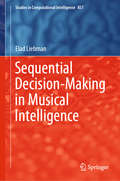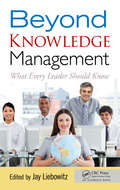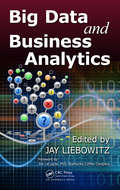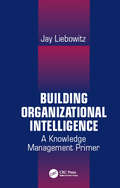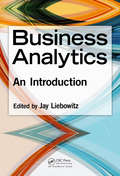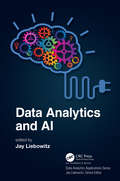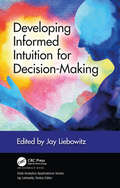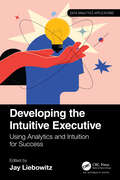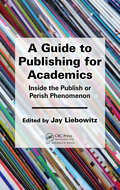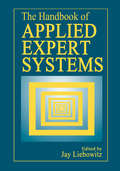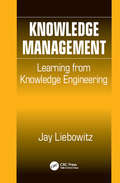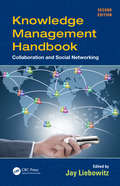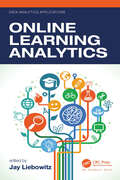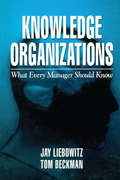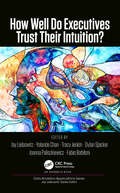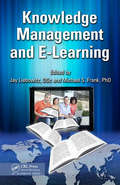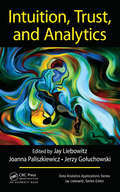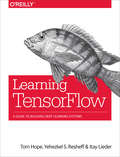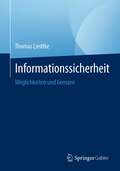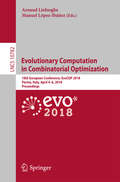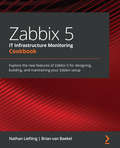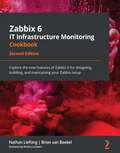- Table View
- List View
Sequential Decision-Making in Musical Intelligence (Studies in Computational Intelligence #857)
by Elad LiebmanOver the past 60 years, artificial intelligence has grown from an academic field of research to a ubiquitous array of tools used in everyday technology. Despite its many recent successes, certain meaningful facets of computational intelligence have yet to be thoroughly explored, such as a wide array of complex mental tasks that humans carry out easily, yet are difficult for computers to mimic. A prime example of a domain in which human intelligence thrives, but machine understanding is still fairly limited, is music. Over recent decades, many researchers have used computational tools to perform tasks like genre identification, music summarization, music database querying, and melodic segmentation. While these are all useful algorithmic solutions, we are still a long way from constructing complete music agents able to mimic (at least partially) the complexity with which humans approach music. One key aspect that hasn't been sufficiently studied is that of sequential decision-making in musical intelligence. Addressing this gap, the book focuses on two aspects of musical intelligence: music recommendation and multi-agent interaction in the context of music. Though motivated primarily by music-related tasks, and focusing largely on people's musical preferences, the work presented in this book also establishes that insights from music-specific case studies can also be applicable in other concrete social domains, such as content recommendation.Showing the generality of insights from musical data in other contexts provides evidence for the utility of music domains as testbeds for the development of general artificial intelligence techniques.Ultimately, this thesis demonstrates the overall value of taking a sequential decision-making approach in settings previously unexplored from this perspective.
Beyond Knowledge Management: What Every Leader Should Know
by Jay LiebowitzAlthough knowledge management (KM) has already helped numerous organizations achieve competitive advantages, many organizations have yet to embark on their knowledge management journey. Geared for executives and senior managers, Beyond Knowledge Management: What Every Leader Should Know is concise and easy-to-read. It looks at 10 areas where organi
Big Data and Business Analytics
by Jay Liebowitz"The chapters in this volume offer useful case studies, technical roadmaps, lessons learned, and a few prescriptions todo this, avoid that.'"-From the Foreword by Joe LaCugna, Ph.D., Enterprise Analytics and Business Intelligence, Starbucks Coffee CompanyWith the growing barrage of "big data," it becomes vitally important for organizations to mak
Building Organizational Intelligence: A Knowledge Management Primer
by Jay Liebowitz"Sharing knowledge is power." If ever there were a field to which this applies, it is the knowledge management industry. And in today's highly-competitive, fast-paced business world, corporations, businesses and organizations in both the public and private sectors are constantly searching for new cutting-edge methods and techniques for creating, storing, capturing, managing, organizing, distributing, combining, and retrieving knowledge. But the task of accomplishing such functions is not as simple as it sounds. Jay Liebowitz's Building Organizational Intelligence: A Knowledge Management Primer gives executives, managers, systems analysts, and other knowledge-management professionals the competitive edge they need in achieving that task. In a concise and easy-to-read format, the book describes the concepts, techniques, methodologies, and tools associated with those functions, and includes mini-case studies and vignettes of how industry is developing and applying these functions towards building organizational intelligence.What's more, the book is packaged with a limited functionality version of "WisdomBuilder," the first in a family of knowledge-management tools that provide a fully integrated solution to the information management and analysis dilemma. Able to run under Windows 95, 98 and NT, "WisdomBuilder" solves the information overload problem by reducing the time and cost of extracting information and other research knowledge from disorganized repositories of heterogeneous data.
Business Analytics: An Introduction
by Jay LiebowitzTogether, Big Data, high-performance computing, and complex environments create unprecedented opportunities for organizations to generate game-changing insights that are based on hard data. Business Analytics: An Introduction explains how to use business analytics to sort through an ever-increasing amount of data and improve the decision-making cap
Data Analytics and AI (Data Analytics Applications)
by Jay LiebowitzAnalytics and artificial intelligence (AI), what are they good for? The bandwagon keeps answering, absolutely everything! Analytics and artificial intelligence have captured the attention of everyone from top executives to the person in the street. While these disciplines have a relatively long history, within the last ten or so years they have exploded into corporate business and public consciousness. Organizations have rushed to embrace data-driven decision making. Companies everywhere are turning out products boasting that "artificial intelligence is included." We are indeed living in exciting times. The question we need to ask is, do we really know how to get business value from these exciting tools? Unfortunately, both the analytics and AI communities have not done a great job in collaborating and communicating with each other to build the necessary synergies. This book bridges the gap between these two critical fields. The book begins by explaining the commonalities and differences in the fields of data science, artificial intelligence, and autonomy by giving a historical perspective for each of these fields, followed by exploration of common technologies and current trends in each field. The book also readers introduces to applications of deep learning in industry with an overview of deep learning and its key architectures, as well as a survey and discussion of the main applications of deep learning. The book also presents case studies to illustrate applications of AI and analytics. These include a case study from the healthcare industry and an investigation of a digital transformation enabled by AI and analytics transforming a product-oriented company into one delivering solutions and services. The book concludes with a proposed AI-informed data analytics life cycle to be applied to unstructured data.
Developing Informed Intuition for Decision-Making (Data Analytics Applications)
by Jay LiebowitzThis book examines how to develop the main traits that are necessary to become an “informed intuitant”. Case studies and examples of successful “informed intuitants” are a major component of the book. “Intuitant” is someone who has the intuitive awareness to be successful. “Informed intuitant” indicates that the individual/decision maker not only applies his/her intuition but also verifies it through using data-driven approaches (such as data analytics). Some of this work resulted from research examining how well do executives trust their intuition.
Developing the Intuitive Executive: Using Analytics and Intuition for Success (Data Analytics Applications)
by Jay LiebowitzThe leading traits of executives often include creativity and innovation. Research shows that intuition can significantly enhance to these traits. Developing intuitive executives and honing intuition, coupled with the ability to apply data and evidence to inform decision making, is the focus of Developing the Intuitive Executive: Using Analytics and Intuition for Success. Some researchers call the complement of applying data analytics to intuition as quantitative intuition, rational intuition, or informed intuition. Certainly, in today's data-driven environment, analytics plays a key role in executive decision-making. However, an executive’s many years of experiential learning are not formally considered as part of the decision-making process. Learning from both failures and successes can help fine-tune intuitive awareness—what this book calls intuition-based decision-making. Research also shows that many executives do not trust the internal data quality in their organizations, and so they rely on their intuition rather than strictly on data. This book presents the work of leading researchers worldwide on intuition in the management and executive domain. Their chapters cover key issues, trends, concepts, techniques, and opportunities for applying intuition as part of the executive decision-making process. Highlights include: Using intuition to manage new opportunities Intuition in medicine Rules based on intuition Balancing logic and intuition in decision-making Smart heuristics to manage complexity Intuition and competitiveness Intuitive investment decision-making across cultures Showing how intuition in executive decision making should play an important role, this book enables managers to complement their knowledge gained from experience with analytics to improve decision-making and business success.
A Guide to Publishing for Academics: Inside the Publish or Perish Phenomenon
by Jay LiebowitzMost academics still wrestle with the "publish or perish" phenomenon. Based on Dr. Liebowitz's 25 years serving as the editor-in-chief of a leading international journal, along with insights from some of the most knowledgeable journal editors, this book shares key lessons learned to help new professors, doctoral students, and practitioner-scholars
The Handbook of Applied Expert Systems
by Jay LiebowitzThe Handbook of Applied Expert Systems is a landmark work dedicated solely to this rapidly advancing area of study. Edited by Jay Liebowitz, a professor, author, and consultant known around the world for his work in the field, this authoritative source covers the latest expert system technologies, applications, methodologies, and practices. The book features contributions from more than 40 of the world's foremost expert systems authorities in industry, government, and academia.The Handbook is organized into two major sections. The first section explains expert systems technologies while the second section focuses on applied examples in a wide variety of industries. Key topics covered include fuzzy systems, genetic algorithm development, machine learning, knowledge representation, and much more.
Knowledge Management: Learning from Knowledge Engineering
by Jay LiebowitzKnowledge Management (KM) is strongly rooted in the discipline of Knowledge Engineering (KE), which in turn grew partly out of the artificial intelligence field. Despite their close relationship, however, many KM specialists have failed to fully recognize the synergy or acknowledge the power that KE methodologies, techniques, and tools hold for enh
Knowledge Management Handbook: Collaboration and Social Networking, Second Edition
by Jay LiebowitzRecent research shows that collaboration and social networking foster knowledge sharing and innovation by sparking new connections, ideas, and practices. Yet these informal networks are often misunderstood and poorly managed. Building on the groundbreaking, bestselling first edition, Knowledge Management Handbook: Collaboration and Social Networkin
Online Learning Analytics (Data Analytics Applications)
by Jay Liebowitz"In our increasingly digitally enabled education world, analytics used ethically, strategically, and with care holds the potential to help more and more diverse students be more successful on higher education journeys than ever before. Jay Liebowitz and a cadre of the fields best ‘good trouble’ makers in this space help shine a light on the possibilities, potential challenges, and the power of learning together in this work." —Mark David Milliron, Ph.D., Senior Vice President and Executive Dean of the Teachers College, Western Governors University Due to the COVID-19 pandemic and its aftereffects, we have begun to enter the "new normal" of education. Instead of online learning being an "added feature" of K–12 schools and universities worldwide, it will be incorporated as an essential feature in education. There are many questions and concerns from parents, students, teachers, professors, administrators, staff, accrediting bodies, and others regarding the quality of virtual learning and its impact on student learning outcomes. Online Learning Analytics is conceived on trying to answer the questions of those who may be skeptical about online learning. Through better understanding and applying learning analytics, we can assess how successful learning and student/faculty engagement, as examples, can contribute towards producing the educational outcomes needed to advance student learning for future generations. Learning analytics has proven to be successful in many areas, such as the impact of using learning analytics in asynchronous online discussions in higher education. To prepare for a future where online learning plays a major role, this book examines: Data insights for improving curriculum design, teaching practice, and learning Scaling up learning analytics in an evidence-informed way The role of trust in online learning. Online learning faces very real philosophical and operational challenges. This book addresses areas of concern about the future of education and learning. It also energizes the field of learning analytics by presenting research on a range of topics that is broad and recognizes the humanness and depth of educating and learning.
Knowledge Organizations: What Every Manager Should Know
by Jay Liebowitz Thomas J. BeckmanFor knowledge management to be successful, the corporate culture needs to be adapted to encourage the creation, sharing, and distribution of knowledge within the organization. Knowledge Organizations: What Every Manager Should Know provides insight into how organizations can best accomplish this goal. Liebowitz and Beckman provide the information companies need for evaluating and planning the steps and processes that will transform their existing organization infrastructure into a "knowledge-based" organization. This easy-to-read guide includes many vignettes, examples, and short cases of organizations involved in knowledge management.
How Well Do Executives Trust Their Intuition (Data Analytics Applications)
by Jay Liebowitz Yolande Chan Tracy Jenkin Dylan Spicker Joanna Paliszkiewicz Fabio BabiloniIn this age of Big Data and analytics, knowledge gained through experiential learning and intuition may be taking a back seat to analytics. However, the use of intuition should not be underestimated and should play an important role in the decision process. <P><P>How Well Do Executives Trust Their Intuition covers the Fulbright research study conducted by this international team of editors. The main question of their investigation is: How well do executives trust their intuition? In other words, do they typically prefer intuition over analysis and analytics. And equally importantly, what types of intuition may be most favorable looking at different variables? The research utilizes survey and biometrics approaches with C-level executives from Canada, U.S., Poland, and Italy. <P><P>In addition, the book contains chapters from leading executives in industry, academia, and government. Their insights provide examples of how their intuition enabled key decisions that they made. <P><P>This book covers such topics as: <li>Using intuition <li>How gender, experience, role, industry, and country affect intuition <li>Trust and intuition in management <li>Trusting intuition <li>It’s a matter of heart <li>Leadership intuition and the future of work <li>Creating an intuitive awareness for executives <li>Improvisation and instinct. <P><P>The book explores how executives can use intuition to guide decision making. It also explains how to trust intuition-based decisions. How Well Do Executives Trust Their Intuition is a timely and prescient reminder in this age of data-driven analytics that human insight, instinct, and intuition should also play key roles.
Knowledge Management and E-Learning
by Jay Liebowitz Michael S. FrankThe rapidly growing demand for online courses and supporting technology has resulted in a plethora of structural and functional changes and challenges for universities and colleges. These changes have led many distance education providers to recognize the value of understanding the fundamental concepts of both e-learning and knowledge management (K
Intuition, Trust, and Analytics (Data Analytics Applications)
by Jay Liebowitz Joanna Paliszkiewicz Jerzy GołuchowskiIn order to make informed decisions, there are three important elements: intuition, trust, and analytics. Intuition is based on experiential learning and recent research has shown that those who rely on their “gut feelings” may do better than those who don’t. Analytics, however, are important in a data-driven environment to also inform decision making. The third element, trust, is critical for knowledge sharing to take place. These three elements—intuition, analytics, and trust—make a perfect combination for decision making. This book gathers leading researchers who explore the role of these three elements in the process of decision-making.
Knowledge Management in Public Health
by Jay Liebowitz Richard A. Schieber Joanne D. AndreadisClose collaboration across agencies and international borders is mandatory for public health officials. A powerful tool for sharing knowledge, knowledge management (KM) can help public health professionals quickly collaborate and disseminate knowledge for solving public health issues worldwide. The latest initiatives for reforming healthcare have put the spotlight on the need for maximizing resources. In addition to providing a platform for sharing knowledge, KM can help healthcare professionals do more with less. One tool, two problems solved. Yet the sharing of knowledge and KM continues to be a major challenge in the public health field. Knowledge Management in Public Health provides a general introduction to KM and social networking in the public health arena. The book begins with coverage of basic principles, components, and methodologies as well as trends and key issues in public health. It includes ten case studies illustrating applications of KM and social networking in public health. The chapters are written by leading individuals from organizations involved in applying KM in public health worldwide. The editors and chapter authors explore the many elements of KM, delineating how and why to start such an initiative. They provide specific examples of the development and value-added benefits of KM in a variety of public health environments. Tough or quick decision making has always benefitted enormously from knowledge based on the maximum amount of pertinent information available at the time—this has not changed. What is new in the present public health environment is the need to do this more often, with fewer personnel available, and increased expectations relative to the services expected by the public. Better use of information under a KM system is well suited to serve that purpose. This book explores the many ways to use KM to anticipate potential health issues and quickly resolve key incidents when they occur.
Learning TensorFlow: A Guide to Building Deep Learning Systems
by Itay Lieder Tom Hope Yehezkel S. ResheffRoughly inspired by the human brain, deep neural networks trained with large amounts of data can solve complex tasks with unprecedented accuracy. This practical book provides an end-to-end guide to TensorFlow, the leading open source software library that helps you build and train neural networks for computer vision, natural language processing (NLP), speech recognition, and general predictive analytics.Authors Tom Hope, Yehezkel Resheff, and Itay Lieder provide a hands-on approach to TensorFlow fundamentals for a broad technical audience—from data scientists and engineers to students and researchers. You’ll begin by working through some basic examples in TensorFlow before diving deeper into topics such as neural network architectures, TensorBoard visualization, TensorFlow abstraction libraries, and multithreaded input pipelines. Once you finish this book, you’ll know how to build and deploy production-ready deep learning systems in TensorFlow.Get up and running with TensorFlow, rapidly and painlesslyLearn how to use TensorFlow to build deep learning models from the ground upTrain popular deep learning models for computer vision and NLPUse extensive abstraction libraries to make development easier and fasterLearn how to scale TensorFlow, and use clusters to distribute model trainingDeploy TensorFlow in a production setting
Digital Crime and Digital Terrorism (3rd Edition)
by John Liederbach Robert W. Taylor Eric J. FritschThis book focuses on both the technical aspects of digital crime as well as behavioral aspects of computer hackers, virus writers, terrorists and other offenders. Using real life examples and case studies, the book examines the history, development, extent and types of digital crime and digital terrorism as well as current legislation and law enforcement practices designed to prevent, investigate and prosecute these crimes. For professionals in the technical field as well as forensic investigators and other criminal justice professionals.
Informationssicherheit: Möglichkeiten und Grenzen
by Thomas LiedtkeDieses Buch erklärt die wichtigsten Fachbegriffe und Inhalte und ordnet diese den entsprechenden Bereichen zu. Einbezogen werden auch scheinbare Randgebiete, die für die Informationssicherheit ebenfalls eine Rolle spielen. So wird der Themenkomplex Safety und Privacy hinsichtlich seiner Gemeinsamkeiten und Unterschiede beleuchtet. Das Buch zeigt aktuell verwendete Angriffsmuster und wie man sich dagegen schützen kann. Schutz muss dabei sowohl auf technischer Ebene (z. B. durch den Einsatz von Kryptographie) als auch auf organisatorischer und personeller Ebene (z. B. durch entsprechende Managementsysteme und Awareness-Schulungen) erfolgen. Wie lässt sich feststellen, wie sicher Daten sind? Wie lassen sich relevante Bedrohungen finden, gegen die man sich schützen muss? Wie verlaufen Risikoanalysen?
Evolutionary Computation in Combinatorial Optimization: 18th European Conference, EvoCOP 2018, Parma, Italy, April 4–6, 2018, Proceedings (Lecture Notes in Computer Science #10782)
by Arnaud Liefooghe Manuel López-IbáñezThis book constitutes the refereed proceedings of the 18th European Conference on Evolutionary Computation in Combinatorial Optimization, EvoCOP 2018, held in Parma, Italy, in April 2018, co-located with the Evo* 2018 events EuroGP, EvoMUSART and EvoApplications. The 12 revised full papers presented were carefully reviewed and selected from 37 submissions. The papers cover a wide spectrum of topics, ranging from the foundations of evolutionary computation algorithms and other search heuristics, to their accurate design and application to both single- and multi-objective combinatorial optimization problems. Fundamental and methodological aspects deal with runtime analysis, the structural properties of fitness landscapes, the study of metaheuristics core components, the clever design of their search principles, and their careful selection and configuration by means of automatic algorithm configuration and hyper-heuristics. Applications cover conventional academic domains such as NK landscapes, binary quadratic programming, traveling salesman, vehicle routing, or scheduling problems, and also include real-world domains in clustering, commercial districting and winner determination.
Evolutionary Computation in Combinatorial Optimization: 19th European Conference, EvoCOP 2019, Held as Part of EvoStar 2019, Leipzig, Germany, April 24–26, 2019, Proceedings (Lecture Notes in Computer Science #11452)
by Arnaud Liefooghe Luís PaqueteThis book constitutes the refereed proceedings of the 19th European Conference on Evolutionary Computation in Combinatorial Optimization, EvoCOP 2019, held as part of Evo* 2019, in Leipzig, Germany, in April 2019, co-located with the Evo* 2019 events EuroGP, EvoMUSART and EvoApplications.The 14 revised full papers presented were carefully reviewed and selected from 37 submissions. The papers cover a wide spectrum of topics, ranging from the foundations of evolutionary computation algorithms and other search heuristics to their accurate design and application to both single- and multi-objective combinatorial optimization problems. Fundamental and methodological aspects deal with runtime analysis, the structural properties of fitness landscapes, the study of metaheuristics core components, the clever design of their search principles, and their careful selection and configuration. Applications cover domains such as scheduling, routing, partitioning and general graph problems.
Zabbix 5 IT Infrastructure Monitoring Cookbook: Explore the new features of Zabbix 5 for designing, building, and maintaining your Zabbix setup
by Nathan Liefting Brian van BaekelDiscover practical recipes to help you efficiently monitor enterprise IT infrastructure for Windows, Linux, and networkingKey FeaturesFind out how you can leverage some of the most exciting features of Zabbix 5Perform professional IT infrastructure and application monitoring on multiple platformsDiscover easy-to-follow, practical solutions to problems in network monitoring with ZabbixBook DescriptionZabbix offers useful insights into your infrastructure performance and issues and enables you to enhance your monitoring setup with its variety of powerful features. This book covers hands-on, easy-to-follow recipes for using Zabbix 5 for effectively monitoring the performance of devices and applications over networks. The book starts by guiding you through the installation of Zabbix and using the Zabbix frontend. You'll then work your way through the most prominent features of Zabbix and make the right design choices for building a scalable and easily manageable environment. The book contains recipes for building items and triggers for different types of monitoring, building templates, and using Zabbix proxies. As you advance, you'll learn how to use the Zabbix API for customization and manage your Zabbix server and database efficiently. Finally, you'll find quick solutions to the common and not-so-common problems that you may encounter in your everyday Zabbix monitoring work. By the end of this Zabbix book, you'll have learned how to use Zabbix for all your monitoring needs and be able to build a solid Zabbix setup by leveraging its key functionalities.What you will learnExplore the different types of monitoring available in Zabbix 5Find out how to build your own Zabbix templatesUse Zabbix proxies for effective load balancing/scalingWork with custom integrations and the Zabbix APISet up triggers and alerting with Zabbix 5Maintain your Zabbix setup for scaling, backups, and upgradesDiscover how to perform advanced Zabbix database managementMonitor cloud-based products such as Amazon Web Services (AWS), Azure, and DockerWho this book is forThis book is for IT engineers who want to get started with Zabbix and anyone with an intermediate understanding of Zabbix looking to extend their knowledge. Although not necessary, prior experience with Zabbix will help you to make the most of this book.
Zabbix 6 IT Infrastructure Monitoring Cookbook: Explore the new features of Zabbix 6 for designing, building, and maintaining your Zabbix setup, 2nd Edition
by Nathan Liefting Brian van Baekel Dmitry LambertDiscover practical recipes to help you efficiently monitor enterprise IT infrastructure for Microsoft Windows, Linux, networking, and moreKey FeaturesFind out how you can leverage some of the most exciting features of Zabbix 6Perform professional IT infrastructure and application monitoring on multiple platformsDiscover easy-to-follow, practical solutions to problems in network monitoring with ZabbixBook DescriptionThis updated second edition of the Zabbix 6 IT Infrastructure Monitoring Cookbook brings you new recipes, updated with Zabbix 6 functionality. You'll learn how to set up Zabbix with built-in high availability, use the improved Business Service Monitoring, set up automatic reporting, and create advanced triggers. Zabbix offers useful insights into your infrastructure performance and issues and enables you to enhance your monitoring setup with its powerful features. This book covers hands-on, easy-to-follow recipes for using Zabbix 6 to monitor effectively the performance of devices and applications over the network.You'll start by working your way through the installation and most prominent features of Zabbix and make the right design choices for building a scalable and easily manageable environment. This Zabbix book contains recipes for building items and triggers for different types of monitoring, building templates, and using Zabbix proxies. Next, you'll use the Zabbix API for customization and manage your Zabbix server and database efficiently. Finally, you'll find quick solutions to the common and not-so-common problems that you may encounter in your Zabbix monitoring work.By the end of this book, you'll be able to use Zabbix for all your monitoring needs and build a solid Zabbix setup by leveraging its key functionalities.What you will learnImplement your high-availability Zabbix setupBuild templates and explore the different types of monitoring available in Zabbix 6Use Zabbix proxies to scale your environment effectivelyWork with custom integrations and the Zabbix APISet up advanced triggers and effective alertingMaintain your Zabbix setup for scaling, backups, and upgradesDiscover how to perform advanced Zabbix database managementMonitor cloud-based products such as Amazon Web Services (AWS), Azure, and DockerWho this book is forThis book is for IT engineers who want to get started with Zabbix and anyone with an intermediate-level understanding of Zabbix looking to extend their knowledge. Although not necessary, prior experience with Zabbix will help you to make the most of this book.
